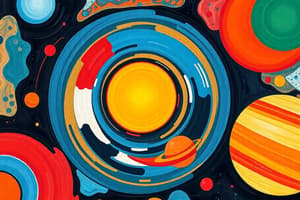Podcast
Questions and Answers
What is the average distance from the sun of the planet Mercury?
What is the average distance from the sun of the planet Mercury?
- 149.6 million km
- 2.88 billion km
- 227.9 million km
- 58 million km (correct)
Which planet is known for having the tallest volcano in the solar system?
Which planet is known for having the tallest volcano in the solar system?
- Earth
- Saturn
- Jupiter
- Mars (correct)
What is the surface temperature of Venus?
What is the surface temperature of Venus?
- Up to 300°C
- Up to 200°C
- Up to 462°C (correct)
- Up to 100°C
How many moons does Jupiter have?
How many moons does Jupiter have?
What is the diameter of the planet Neptune?
What is the diameter of the planet Neptune?
What is the name of the region of icy bodies beyond Neptune where Pluto is located?
What is the name of the region of icy bodies beyond Neptune where Pluto is located?
What is the name of the largest object in the asteroid belt?
What is the name of the largest object in the asteroid belt?
How many dwarf planets are mentioned in the text?
How many dwarf planets are mentioned in the text?
Flashcards are hidden until you start studying
Study Notes
Overview
- The solar system consists of eight planets, five dwarf planets, and other smaller celestial bodies
- Formed approximately 4.6 billion years ago from a giant cloud of gas and dust called the solar nebula
The Planets
Inner Planets
- Mercury
- Closest to the sun, average distance of 58 million km
- Smallest planet, diameter of approximately 4,879 km
- Highly eccentric orbit
- Venus
- Hottest planet, surface temperature up to 462°C
- Thick atmosphere, composed mostly of carbon dioxide
- No moons
- Earth
- Third planet from the sun, average distance of 149.6 million km
- Only known planet to support life
- One large moon
- Mars
- Known as the Red Planet due to iron oxide in the soil
- Average distance from the sun of 227.9 million km
- Has the tallest volcano in the solar system, Olympus Mons
Outer Planets
- Jupiter
- Largest planet, diameter of approximately 142,984 km
- Gas giant, composed mostly of hydrogen and helium
- 79 known moons
- Saturn
- Second largest planet, diameter of approximately 116,460 km
- Known for its prominent ring system
- 62 known moons
- Uranus
- Seventh planet from the sun, average distance of 2.88 billion km
- Tilted axis, resulting in extreme seasons
- 27 known moons
- Neptune
- Eighth and farthest planet from the sun, average distance of 4.46 billion km
- Coldest planet, with temperatures as low as -224°C
- 14 known moons
Dwarf Planets
- Pluto
- Located in the Kuiper Belt, a region of icy bodies beyond Neptune
- Diameter of approximately 2,374 km
- Eris
- Located in the scattered disc, a region beyond the Kuiper Belt
- Diameter of approximately 2,326 km
- Haumea
- Located in the Kuiper Belt
- Unusual shape, resembling a rugby ball
- Makemake
- Located in the Kuiper Belt
- Highly inclined orbit
- Ceres
- Located in the asteroid belt between Mars and Jupiter
- Largest object in the asteroid belt
Solar System Overview
- Formed approximately 4.6 billion years ago from a giant cloud of gas and dust called the solar nebula
- Consists of eight planets, five dwarf planets, and other smaller celestial bodies
The Planets
Inner Planets
- Mercury: closest to the sun, with an average distance of 58 million km, and a diameter of approximately 4,879 km
- Venus: hottest planet, with a surface temperature up to 462°C, and a thick atmosphere composed mostly of carbon dioxide
- Earth: third planet from the sun, with an average distance of 149.6 million km, and the only known planet to support life
- Mars: known as the Red Planet due to iron oxide in the soil, with an average distance from the sun of 227.9 million km, and the tallest volcano in the solar system, Olympus Mons
Outer Planets
- Jupiter: largest planet, with a diameter of approximately 142,984 km, composed mostly of hydrogen and helium, and 79 known moons
- Saturn: second largest planet, with a diameter of approximately 116,460 km, known for its prominent ring system, and 62 known moons
- Uranus: seventh planet from the sun, with an average distance of 2.88 billion km, and a tilted axis, resulting in extreme seasons, and 27 known moons
- Neptune: eighth and farthest planet from the sun, with an average distance of 4.46 billion km, and the coldest planet, with temperatures as low as -224°C, and 14 known moons
Dwarf Planets
- Pluto: located in the Kuiper Belt, with a diameter of approximately 2,374 km
- Eris: located in the scattered disc, with a diameter of approximately 2,326 km
- Haumea: located in the Kuiper Belt, with an unusual shape, resembling a rugby ball
- Makemake: located in the Kuiper Belt, with a highly inclined orbit
- Ceres: located in the asteroid belt between Mars and Jupiter, and the largest object in the asteroid belt
Studying That Suits You
Use AI to generate personalized quizzes and flashcards to suit your learning preferences.




